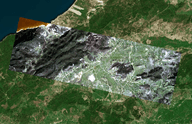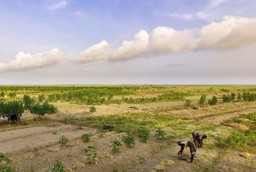Making food demand more sustainable
In spite of having access to nearly half of the world’s uncultivated land that is suitable for farming, Africa has the highest poverty rate in the world. Understanding the nature and distribution of croplands can support the development of strong agricultural policies and sustainable farming practices that will meet increasing food demand in Sub-Saharan Africa for generations to come.
Element 84 partnered with the Agricultural Impacts Research Group at Clark University to expand upon their proof-of-concept Mapping Africa project, which seeks to quantify smallholder agriculture in Africa using a combination of remotely sensed imagery, crowdsourced annotation data, and machine learning techniques. This project is a great example of Element 84’s focus on building tools that support the United Nations’ Sustainable Development Goals (SDGs), a global blueprint for ending poverty, fighting inequality, and addressing the impacts of climate change by 2030.
Scaling up data with machine learning tools
Advances in satellite and remote sensing technology are providing critical new sources of data for supporting SDGs and creating a brighter future for even the poorest nations. But these datasets are often enormous, and working with them effectively can be very challenging.
Element 84 has extensive experience using machine learning tools to extract useful information from large geospatial datasets through the development of our open source Raster Vision and GeoTrellis projects. We were able to apply this expertise to Mapping Africa in a variety of ways, making it possible for Lyndon Estes and his team to scale the prototype and get it ready for broader use as a production application.
Creating cloud-free imagery for seasonal analysis
We began our work by creating a cloud-free representation of both the growing season and the non-growing season in Ghana using Planet Labs’ PlanetScope satellite imagery. This would enable the Mapping Africa team to better distinguish cropland from non-cropland in the imagery, and to identify individual agricultural fields that might otherwise have been obscured by the clouds.
To create the mosaic, we applied a cloud detection algorithm that would check Planet’s daily imagery collection and find the least cloudy scenes.
Reducing hunger and improving policy-making
Element 84’s contributions to Mapping Africa are helping Clark University produce accurate, high resolution cropland maps that will enable policymakers, smallholder farmers, humanitarian relief organizations, and a range of other stakeholders to make informed decisions that will address increasing food demand in a scalable and sustainable manner.
“We are very excited to continue refining and applying our platform, which we intend to use to produce high accuracy, high resolution cropland maps for all of Ghana by the end of this year. We feel confident that we can achieve this goal, now that we have the highly scalable and robust machine learning pipeline developed by Element 84.”
Lyndon Estes



